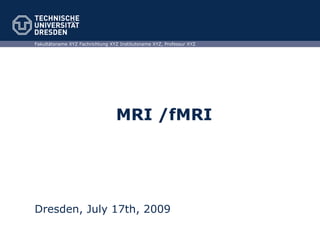
Mri Fmri
- 1. MRI /fMRI Dresden, July 17th, 2009 Fakultätsname XYZ Fachrichtung XYZ Institutsname XYZ, Professur XYZ
- 7. Mikro-/Makroskopisch Resonanz Protonen richten sich parallel und antiparallel zum äußeren Magnetfeld aus Nettomagnetisierung: (N+) – (N- ) ~6 ppm !!! (1T)
- 8. Prinzip
- 9. Elektromagnetische Spektrum MRI X-Ray, CT
- 10. Resonanz:
- 11. Komponenten
- 16. Anregung und Relaxation Nach jeder Störung durch einen HF-Puls nehmen die Spins wieder ihren Grundzustand ein, sie »erholen« sich. Diese RELAXATION können wir durch zwei voneinander unabhängige Prozesse beschreiben, indem wir Längsmagnetisierung und Quermagnetisierung getrennt betrachten.
- 17. T1-Relaxation Eine RELAXATION ist ein dynamischer Prozess: Ein System kehrt aus einem Nichtgleichgewichtszustand in sein Gleichgewicht zurück. Die Energie der angeregten Spins geht durch Wechselwirkung mit dem ➔ Gitter wieder verloren
- 18. T1-Relaxation
- 19. T2-Relaxation
- 21. Messprinzip
- 22. Signaldetektion
- 24. 180°-Puls
- 25. Spin-Echo
- 26. Kontraste
- 27. Kontraste
- 28. Kontraste
- 29. Kontraste
- 30. T2-Kontraste
- 34. Ortsauflösung: Gradienten Magnetic gradient fields increase or reduce linearly the static magnetic field B 0 , resulting in a linear change of precessional frequency. The change in precessional frequency is directly proportional to the distance from the center of the magnet
- 35. Backprojection
- 70. TU Dresden, 21.08.09 Präsentationsname XYZ Folie von XYZ
Hinweis der Redaktion
- A magnet is a magnetic dipole and it can be represented by a magnetic vector. A moving magnetic field induces a current in a loop of wire. For example, the rotating magnet below induces a sinusoidal current that can be recorded. MRI coils can be used for transmitting and/or receiving. As it is not possible to receive RF signal in the same axis as B 0 , coils are only sensitive to variations of transverse magnetization vector. Quadrature RF coils (circularly polarized coils) consist of at least two coils that are oriented orthogonal to each over (and both are othogonal to B 0 axis). They have a better signal to noise ratio than linear RF coils.
- After a 90° RF pulse, net magnetization tips down so that longitudinal magnetization has disappeared and transverse magnetization has appeared. Once the RF transmitter is turned off, relaxation happens : transverse magnetization decays longitudinal magnetization recovers protons re-radiate the absorbed energy Coils can receive the signal in the transverse plane due to variations of transverse magnetization vector. This signal is oscillating at resonance frequency and signal enveloppe is a decay curve described as an exponential curve. In absence of any magnetic gradient, this signal is called Free Induction Decay (FID). FID signal decays faster than T 2 would predict and decreases exponentially at characteristic time constant T 2 * . T 2 * takes into account : tissue specific spin-spin relaxation (random interactions between spins) responsible for pure T 2 decay static inhomogeneities in magnetic fields which accelerate spins dephasing
- A 180° RF pulse can rephase spins and reverse static field inhomogeneities. After a 90° RF pulse, spins dephase and transverse magnetization decreases. If we apply a 180° RF pulse, spins rephase and transverse magnetization reappears How can a 180° RF pulse rephase spins? Consider the following race: Once the race starts (the relaxation begins), the turtle and the rabbit are at the same place (the starting line): they are in phase. As the rabbit runs faster, there is a distance between him and the turtle: they dephase. Then both have to turn around and go back (180° RF pulse) Assuming they are both going at the same speed as before, they arrive at the same time at the starting (finish) line : they rephase.